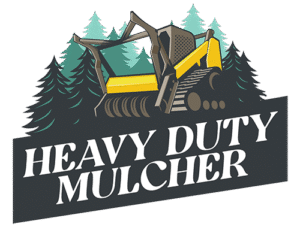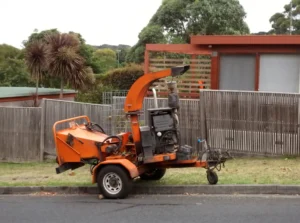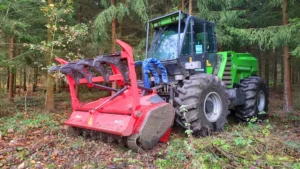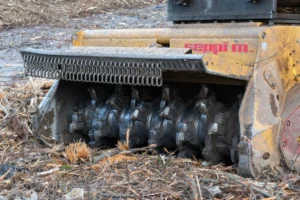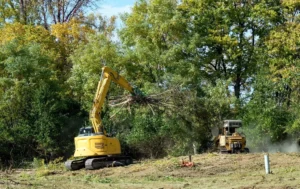High performance is not a claim, it is the result of balanced hydraulics, cool running systems, a rigid cutting head, and an operator who can see clearly and work precisely. The best setups reach speed quickly, hold it under load, keep chips going down, and finish the shift as strong as they started. Use this guide to evaluate a machine in the yard, then apply the habits that keep output steady in real vegetation and real weather.
Power delivery and hydraulic balance
Consistent production begins with oil flow and pressure that match the head, then remains stable as temperature rises. If the rotor hesitates to reach speed or bogs as soon as you feed, the system is out of balance. A matched pump and motor hold speed, protect cut quality, and control fuel burn. Confirm with a warm machine, a gauge, and a short test cut so numbers support what you feel in the cab.
Flow, pressure, and motor selection
The head needs enough flow to reach working speed and enough pressure to hold torque when you feed. Too little flow invites heat and dust, too much pressure without relief hammers mounts and belts. Verify the requirement at temperature on the test ports, and make sure motor displacement puts the rotor in its intended power band, not too fast with no bite, not too slow with excess load. For a step by step setup you can brief, see the Operator Guides.
What to check
- Required flow and pressure match the carrier at operating temperature
- Smooth spin up with steady speed while feeding light brush
- Relief valves are accessible and documented for accurate settings
- Case drain routing is clean with an easy place to measure flow
- Readings are written on your pre start sheet for trend tracking
When the head reaches speed quickly and stays there under a measured bite, you have the foundation of true field performance.
Cooling and temperature control
Performance fades when oil runs hot. Cooling packs must breathe clean air, fans must reverse on schedule, and screens must seal so dust does not bypass the core. Plan short cleanouts before temperatures creep upward, then give the machine a brief idle to pull heat from hot spots. A steady rise during a constant task often points to restricted airflow or dull teeth. Keep the routine tight with the maintenance checklists.
Control the heat
- Hinged screens that open without tools for fast cleaning
- Reversible fan with manual override and a strong cycle for dusty days
- Clear view of hydraulic and engine temperatures in the cab
- Planned cleanouts written in the briefing, not postponed to alarms
- Chip quality checked often, dust clouds usually mean heat and dull edges
Cool oil keeps power consistent and extends component life.
Fuel efficiency and duty cycle
High performance includes output per liter. Smooth hydraulic balance, sharp teeth, and controlled feed limit wasted energy. Keep passes light enough to hold rotor speed, then add a finish pass instead of one heavy push. Use a consistent overlap pattern so you do not regrind material.
Improve output per liter
- Hold steady rotor speed with measured feed
- Use patterns with consistent overlap to limit regrinding
- Keep teeth sharp and matched to the vegetation
- Plan short cool downs that align with cleanouts
- Record area, fuel, and average temperatures for every shift
Log fuel against cleared area so crews learn what good looks like in your stand and season.
Cutting head design and tooth strategy
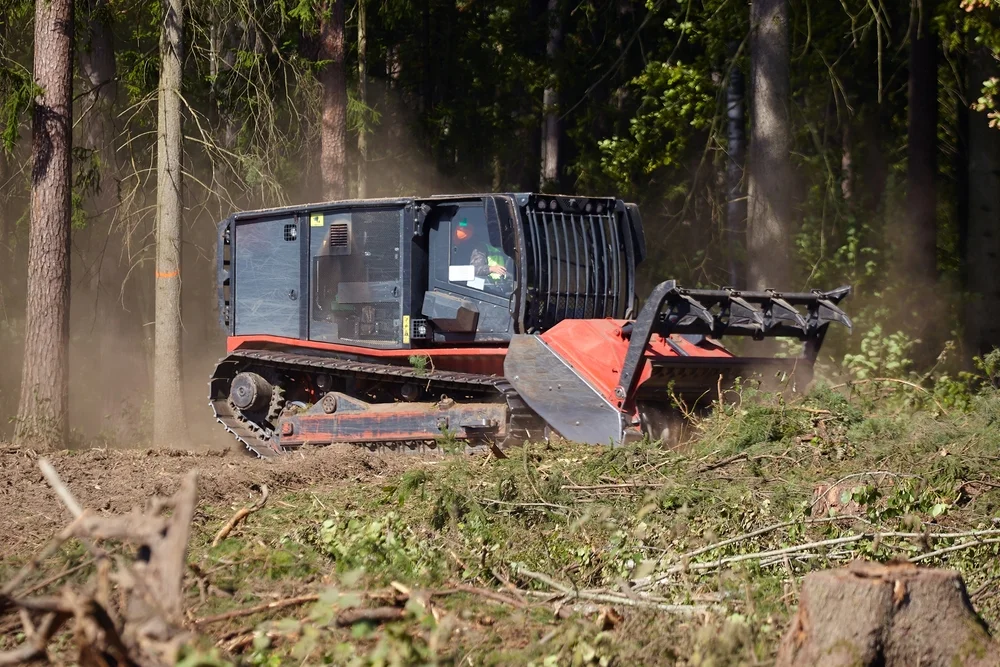
The head turns power into clean work. A straight, balanced rotor on protected bearings, a tooth system that locks hard and swaps fast, and guarding that keeps chips down are the practical markers of a high performance setup.
Rotor balance and inertia
A good rotor behaves like a flywheel. It reaches speed without chatter, stays centered, and holds momentum as you feed. Balance matters because vibration eats bearings, loosens hardware, and forces operators to slow down.
Field signals of a good rotor
- Smooth run up and coast down with no visible wobble
- Stable sound under load, no harmonic chatter through the cab
- End caps and mounts with realistic torque values and tool access
- Bearing guards with rope cutters and seal protection at both ends
- Space to clean around housings so heat and debris do not build
Inspect for smooth spin down, listen for scrape or wobble, and torque mounts with a real tool rather than by feel.
Tooth type, pattern, and edge management
Teeth decide bite and finish. Carbide stays productive in mixed, dirty stands and rocky ground, sharp steel gives a fine finish in clean wood and lowers load when you can keep the head off soil. Pattern and stagger control chip size and bite depth. Rotate or replace at fifty percent wear to hold cut quality and temperature.
Match teeth to the job
- Carbide for mixed or rocky material, steel for clean wood and fine finish
- Pattern that spreads bite evenly around the rotor for smooth load
- Rotation routine recorded on a simple wear log
- Hardware kit and the correct torque tool staged on the service truck
- Visual check of chip size, dust means dull edges or wrong pattern
For corridor work beside live traffic, controlled discharge also protects the public and signals, which is covered in roadside and railway clearing.
Discharge control and finish quality
High performance leaves chips down and sightlines clear. Doors, curtains, and deflectors should manage throw so you can run confidently near roads, rails, and public areas.
Control the output
- Door closed for controlled feed, open only when the technique requires it
- Curtains that fully cover the opening with no gaps
- Side deflectors that stay stiff so chip flow remains downward
- Patterns that feather edges and avoid windrows
- Document mulch depth and visibility lines in the briefing
Keep discharge directed away from traffic and water, choose patterns that do not snowplow material, and hold a finish depth of two to three inches so soil is protected and access remains open.
Control, visibility, and operator ergonomics
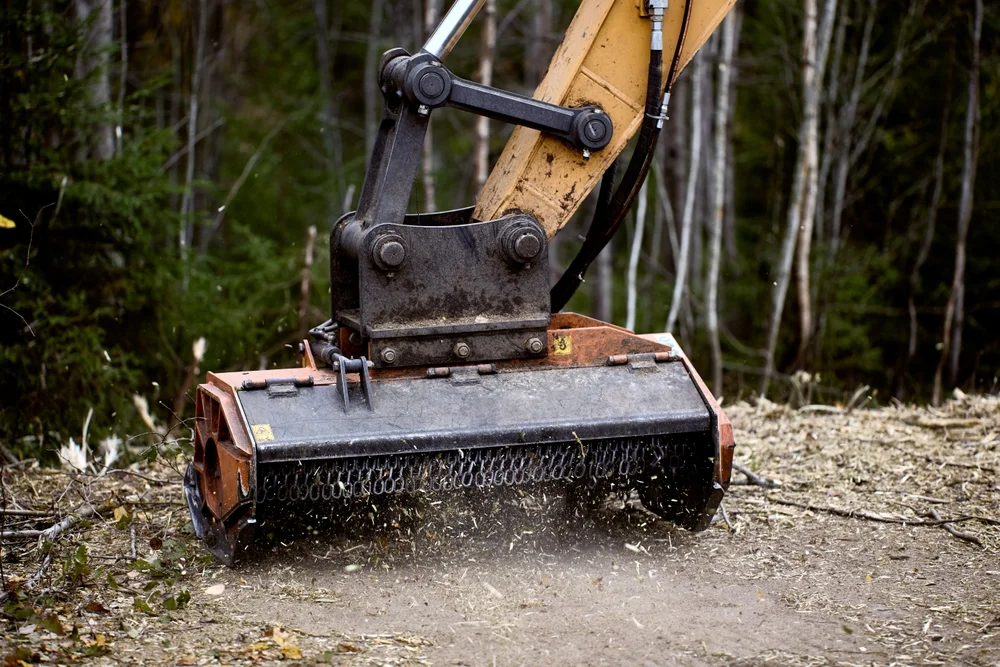
Power is wasted if the operator cannot see or modulate movement. High performance cabs combine certified protection with clear sightlines, precise low speed control, and a layout that reduces fatigue. When the operator can place the head exactly where it is needed, pass quality and speed both improve.
Cab protection and sightlines
ROPS and FOPS keep crews safe, clean glazing and smart guards keep the view open. Wipers and lights matter when dust and low sun make visibility difficult. Cameras help in tight corridors and during backing near staging. Seat belts are worn, doors latch properly, exits work with gloves on.
Visibility must haves
- Intact glazing with no starred impacts, clean wipers and washers
- Guards that protect without blocking essential lines of sight
- Work lights and cameras aimed for night and dust, easy to wipe clean
- Mirrors or displays placed where eyes already travel during work
- Seat and belt that fit the operator so posture stays neutral
For a full checklist of protection and guarding, align with OSHA and ANSI safety standards.
Precision controls and low speed modulation
Fine control at low speed lets crews work close to assets and on slopes. You want smooth response on travel and boom, predictable head engagement at idle, and easy modulation of feed. Control checks
- Smooth travel and boom response at idle without lurch
- Predictable head engagement at low engine speed
- No delay or surge when feathering into material
- Radios tested with a clear stop word during the briefing
- Lockout points simple and obvious for safe close inspection
Radios are checked at the start of every shift so the stop call is heard the first time.
Cutting patterns on slopes
Patterns decide how much power reaches the cut. On grades, contour passes with measured overlap keep the rotor loaded without bog and avoid snowplowing that compacts soil. Plan turn pockets on firm benches, keep heavy components uphill, and add a light finish pass for surface quality.
Slope habits that hold output
- Travel across contour where possible for stability and even bite
- Keep overlap consistent so the head does not regrind material
- Lower the head to reduce center of gravity if sliding begins
- Feather edges so rainfall does not create rills at the boundary
- Pre plan recovery routes and anchors before moving onto grades
For terrain specific notes and soil protection, see forestry operations.
Uptime engineering and serviceability
You cannot produce if you cannot run. Access, fasteners, diagnostic ports, and parts support are the quiet drivers of performance. Machines that hinge, unlatch, and show real readings let crews keep them at peak without drama.
Access points, fasteners, and daily checks
Screens should open without a second set of hands, grease points should be visible and reachable from safe positions, and common fasteners should match tools already on the truck.
Design choices that save minutes
- Hinged screens and lids with stays, not hidden fasteners
- Grease points labeled to match the manual
- Captive nuts and common sizes across guards and mounts
- Belt tensioners reachable without stripping unrelated parts
- Storage for lockout pins and a tag point near the ignition
If a guard comes off every day, it should use captive hardware and a sensible size. Fast service creates the habit that prevents drift.
Smart diagnostics and useful data
Operators protect machines when they can see what matters. Clear views of temperature and pressure, easy access to case drain and test ports, and fault codes that describe real issues turn symptoms into fixes. Add a simple place to write readings on the pre start sheet and you build a baseline for every unit.
Diagnostics that help
- Live temperature and pressure in the cab, easy to glance during work
- Labeled test ports with caps that seal
- Fault codes described in plain language
- Cameras and lights that give a clear view in dust and low sun
- Space on the checklist to jot readings and notes
For program level habits that extend life across seasons, review long term care of industrial mulchers.
Parts and support ecosystem
Performance includes how fast you get back to work after wear or a strike. Builders who stock common items and publish real diagrams reduce downtime. Keep a small wear kit on the truck, teeth and hardware, belts, bearings, filters, and common fuses.
Keep the line moving
- Real parts diagrams with callouts and torque values
- Stock on common wear items and quick shipping for the rest
- Phone support that answers with practical steps
- Serial tracking for updates and service bulletins
- A field kit on your truck so swaps do not stall the shift
Order long lead parts when wear reaches halfway, not when it fails.
A one hour field test for real performance
Judge a setup quickly. Warm the unit, record baseline temperatures and pressure, then cut a mixed stand. Watch spin up, listen for chatter, and check chip size. Reverse the fan, open the screens, clean once, and note how easy the machine is to service. Record temperatures again and compare to baseline. Torque one tooth and one guard bolt to feel the hardware.
Quick test steps
- Warm to operating temperature and log baseline readings
- Make light, then moderate passes, watching speed hold and chip quality
- Reverse the fan, open screens, and clean, judging access and time
- Log temperatures and pressure again to confirm stability
- Inspect finish, discharge control, and visibility around the cab
If numbers stay steady and the machine feels tight, you are looking at a high performance pairing.
“High performance is the feeling you get when the rotor stays steady, the oil stays cool, and the crew never has to fight the machine. That is design meeting method.”
— James Carter, Operations Director
Ready to lift field performance
If you want a one page operator checklist matched to your carrier and head, plus a pattern plan for your terrain and a temperature control routine your crew can brief in minutes, we can help. Share vegetation, slope, proximity to utilities, and the finish you need. We will send a simple plan you can use on your next window.
Contact us for a tailored setup.
